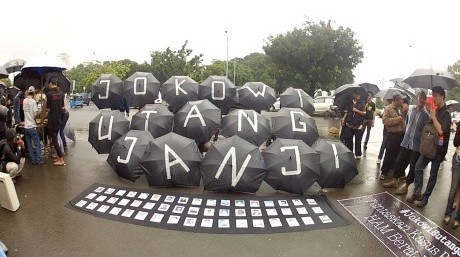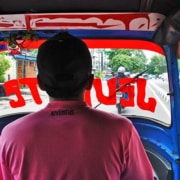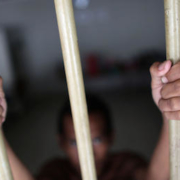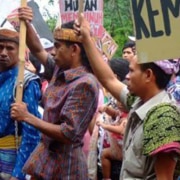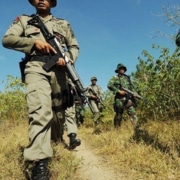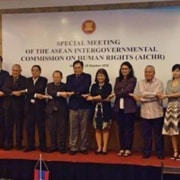
Activists have expressed disappointment that those affected by rights violations have not been given a prominent position in the newly formed government committee to resolve past abuses. Photo by Ucu Agustin
On Thursday 11 June, from 4 to 5pm, victims of human rights violations and their relatives gathered for the 400th time in front of the Presidential Palace in Jakarta for the weekly Kamisan (Thursdays) protest. Flanked by representatives of civil society organisations and members of the public, Kamisan participants demand attention for past and present human rights abuses. Specifically, they ask for perpetrators of human rights violations to be arrested and held to account in a legal process. These claims articulate criticism of a state that, 17 years after the fall of the Suharto regime, remains largely unresponsive towards human rights violations.
Kamisan was initiated in January 2007 by families of victims of human rights violations, and is supported by human rights organisations such as The Commission for the Disappeared and Victims of Violence (KontraS). The protest brings together individuals concerned with various human rights cases: from those committed during Soeharto’s New Order, such as the 1965/1966 mass killings and the disappearance of human rights activists in 1997/1998, to more recent cases, including the murder of human rights activist Munir Said Thalib in 2004 and the persecution of the minority Islamic group Ahmadiyah.
While Kamisan was initially conceived as a silent protest, the gathering regularly includes the reading of statements by participants, as well as songs and music. Every week, participants don black clothes and carry banners with the photos and names of victims, sometimes bringing flower petals (commonly used when visiting graves) and candles.
But most conspicuous are the black umbrellas, which carry the name of a particular case, or slogans such as “Do not be silent: resolve human rights violations” and “Do not forget”. While the umbrellas serve a practical purpose, offering protection from rain and sunshine, to the participants they also symbolise the protection and strength of faith. Each gathering concludes with the participants handing a letter addressed to the president to the police guarding the palace, and a prayer.

Many activists hoped that the election of President Jokowi would bring justice for victims of human rights violations. Photo by Ucu Agustin.
On the occasion of its 400th iteration, the inevitable question is what this protest has been able to achieve. As time passes, physical participation for some victims has become difficult. This is particularly so for those associated with the 1965/1966 killings and its aftermath, who are becoming old. Moreover, victims and relatives of human rights violations have expressed their weariness, as true acknowledgement from the state remains elusive.
In May, the government announced plans to establish a reconciliation committee to resolve past abuses. A joint team comprised of the Attorney General’s Office, the National Police, the Coordinating Ministry of Political, Legal and Security Affairs, the State Intelligence Agency (BIN) and the National Commission on Human Rights (Komnas HAM) agreed to establish the committee to seek a non-legal solution to past gross violations of human rights. Although there will be an avenue for inclusion of victims and their families in this process, activists have expressed their disappointment that those directly affected by human rights violations have not been given a more prominent position. In addition, for many Kamisan participants, the move represents another attempt from the state to absolve itself of its obligations to investigate past abuses and have them tried in an ad hoc human rights court.
In light of these developments, the significance Kamisan cannot be underestimated. First, the importance of this protest is in its consistency. The persistence of the protest has been an important factor in its spread to other cities in Indonesia. It can now be found each Thursday in Bandung, Batam and Yogyakarta, among other cities. Much as protesters gather in front of the Presidential Palace in Jakarta, initiators in other cities have chosen public spaces that symbolise power as a site of protest: Kamisan in Bandung is held in front of the Governor’s Office (Gedung Sate), outside the Regional Legislative Council (DPRD) in Batam, and at Tugu in Yogyakarta, a prominent landmark linked to the first sultan of the city.
The choice for places that represent political power underlines Kamisan’s claim that the state must bear responsibility for human rights issues. By holding the protests in these places, the protest also contrasts the position of the duty bearers (the state) to that of the rights holders, and places victims and their relatives in the public sphere. The presence of individuals long denied justice in such a space increases the visibility of their cases.
Second, Kamisan is significant in the political claims it puts forward. The protest brings together various cases of human rights violations, spanning a period of 50 years. As such, Kamisan links individual stories of loss and suffering in a shared experience of resistance and in a broader endeavour: the implementation of human rights in Indonesia. In putting forward this political claim, Kamisan has placed personal experiences in a political discourse.
By binding individuals together in a public space symbolising political power, the importance of Kamisan is that it contributes to making human rights violations both visible and political.


